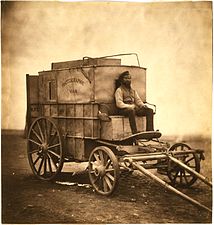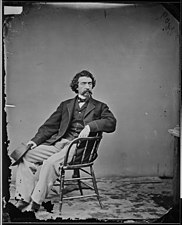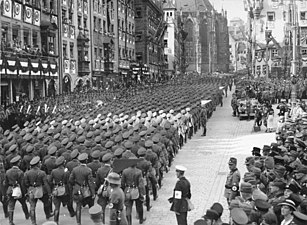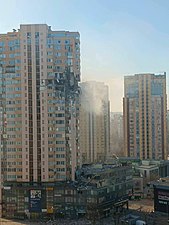Wikipedia:Wikipedia Signpost/2022-02-27/Serendipity
War photographers: from Crimea (1850s) to the Russian invasion of Ukraine (2022)
"The first casualty when war comes is truth" is a well-known quote. It is sometimes attributed to Hiram Johnson but probably older than this quote by Johnson from 1929: “The first casualty when war comes is truth and whenever an individual nation seeks to coerce by force of arms another, it always acts, and insists that it acts in self-defense" (Locomotive Engineers Journal, February 1929, p. 109). Does that remind anyone of a recent war?
Here we present a tour of war photography. We start in Crimea in 1855 and end it in Kyiv, about 550 miles to the north, about 165 years later. This tour makes stops in the United States in the 1860s, Europe in the 1930s and 1940s, and Vietnam in the 1970s.
Roger Fenton & the Crimean War (1850s)
The Crimean War (1853-1856) was a war in which Russia lost to an alliance of France, England, the Ottoman Empire and Piedmont-Sardinia. The image of that war is largely captured by drawings and paintings (Charge of the Light Brigade), but there were also photographers wandering around, notably Roger Fenton. (Perhaps I should use the words "driving around", because as shown below, camera equipment in those days required a vehicle to transport.) Fenton didn’t capture the cruelties of war, but gave a lively picture of the environment of the Crimean War.
-
Roger Fenton’s photographic van
-
3rd Light Dragoons, British Army (photo by Roger Fenton)
-
Valley of Death (version with cannonballs, by Roger Fenton)
American Civil War
Probably the first real war photographs were made by Mathew Brady in the American Civil War, around 1862. His bloody photographs paint a horrific image of the reality of war.
-
Mathew Brady
-
Confederate dead, Second Battle of Fredericksburg (1863)
-
American Civil War (1863)
Spanish Civil War, World War II
Wars produce iconic photographs. Robert Capa will be mainly remembered for his photos of the Spanish Civil War (The Falling Soldier, 1936), but he also made photographs during World War II in Germany. War photographs can also be used as a weapon: the weapon of propaganda. It is well known that governments always try to prevent photographs of war scenes and body bags from being widely circulated. These photos influence public opinion. Joseph Goebbels, Hitler’s propaganda chief, used photographs to effectively work the minds of the German people.
-
The ruins of Guernica
-
Veterans of the 3rd Ukrainian Front march in Red Square in Moscow's 1945 victory parade
-
Leni Riefenstahl photographing Adolf Hitler, 1934
Vietnam
The opinion of the American people on the Vietnam War was heavily influenced by photos – think of the Execution of Nguyễn Văn Lém, a photo by Eddie Adams of the Saigon execution in 1969, or the picture by Nick Ut of children hit by napalm attacks in 1972.
-
Photographer Eddie Adams
-
World Press Photo 1973
Russian invasion of Ukraine
The Russian invasion of Ukraine began less than a week ago. Wikipedia is the encyclopedia that anyone can edit, and consequently, anyone in Ukraine with pictures to share can upload them to Wikipedia. Look carefully, and keep in mind that photographs are used to gain influence. So far, only a few photos have been uploaded to Wikimedia Commons. The Wikipedia editing event for Ukraine's Cultural Diplomacy Month 2022 was still being supported by the organizers as of February 24. While the event's call is for text editing, anyone who wants to join current editorial discussions about Ukraine – whether for current events or any other part of society – can talk to editors on the talk page there. Be aware that the discussion may be difficult.
-
Wreckage in Eastern Ukraine, Feb. 2022
-
-
Residential building hit by a Russian rocket
-
Wreckage in Kyiv, 24 Feb. 2022
















Discuss this story
Metadata, photos, prints, paintings, and secure reuse
Interesting article, thanks for posting. It does inspire me to poke around other war images, whether photographs or prints and paintings. Is there any reason for just including these wars? So many war photos are on Commons with lousy metadata and some have been used for entirely different conflicts!
I am going to assume you picked undisputed ones. It would be interesting to do the same exercise for paintings, which are often painted well after the fact, with a particular slant by the commissioner. I did do some work at some point on artist depictions of WWI and especially artists that died in WWI (sorry, can't remember who or which country now). The images of Ukraine are refreshing to have, we so rarely have secure images of breaking news though articles tend to grow quickly. I was got curious about an image that has become iconic for the Ukrainian struggle, and discovered it was already popular during the Crimean crisis of 2014. Digging around, still no closure on the work of the artist, which appears incomplete for the more graphic depictions.
I was going to update The Apotheosis of War article but then I realized we should have the whole series. It would be nice to track those down, but also to find other war works by artists reused for pacifism in later conflicts. Jane (talk) 10:42, 1 March 2022 (UTC)[reply]